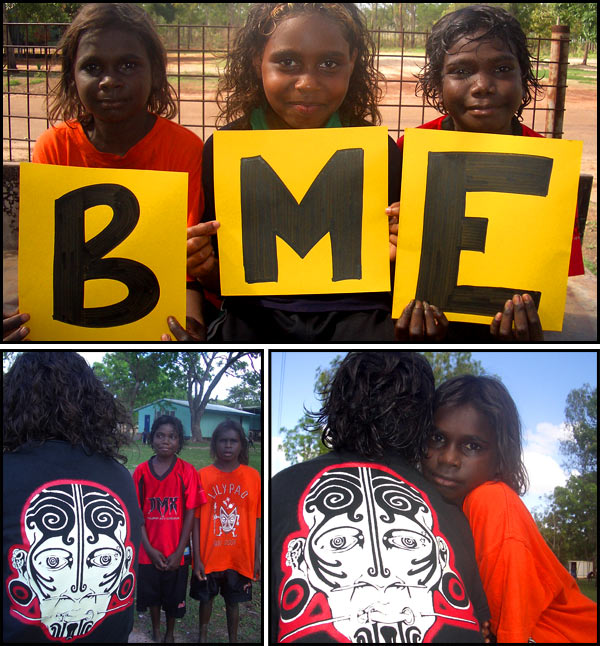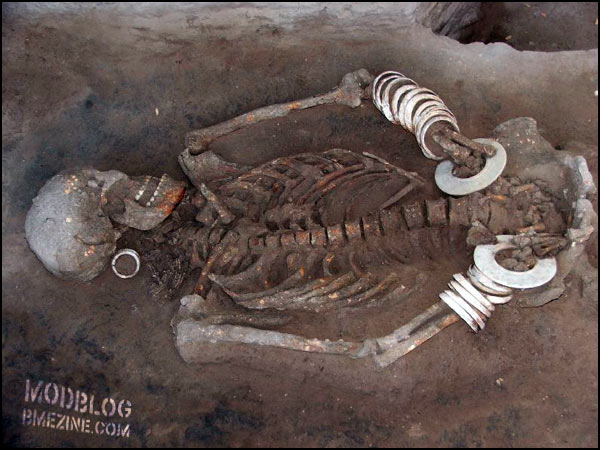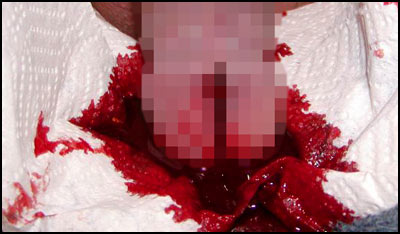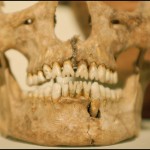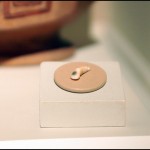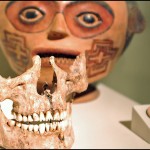Digger (“punk rock prehistorian” — check out his page to see his superb petroglyph tattoos and more pictures like this) sends in these photos of a Thai bronze age burial excavation (click through for a second photo), showing shell and marble bracelets as well as large shell ear tunnels.
Tag Archives: history
Post navigation
Kuna Woman’s Septum Piercing
Fruits, who lives in Panama, sends in this shot of a Kuna woman in Panama and her tight gold septum ring…

Jim Ward Audio Interview
Xeni over at BoingBoing has posted a nice follow-up interview with Jim Ward (available both in audio and in transcript form) about both piercing history, and the Louie (father of Karl) Rove piercing story. Click the picture of Jim to jump right to the interview now.
Piercing History and Political History Intersection
St. Galien, I say!
I recently picked up A Mind of Its Own by David M. Friedman, “a cultural history of the penis”. In a chapter on discussing early views of semen and masturbation, I ran across a fascinating story related to doctors attacking genitals in unpleasant various ways in order to curb “self-pollution” —
These doctors were certain they were saving their patients from themselves. Unrestrained, boys were likely to re-create the terrifying example of a French shepherd named Gabriel Galien, whose case was described in 1792 by the surgeon François Chopart. According to Chopart, Galien became a compulsive masturbator at age fifteen. Over time, however, normal stimulation was insufficient for climax, and Galien began to tickle his urethral canal with a long wooden splinter. His occupation allowed him the solitude and free time to perfect that methodology. But eventually Galien became inured to this new technique as well. So he used a knife to make a long slit on the underside of his penis, attempting to enlarge his urethral passage. This (at first) shallow incision, Chopart wrote,
which in any other man would have produced the sharpest pain, instead procured for [Galien] an agreeable sensation and complete ejaculation …. Finally, given all the effort of his passions, he managed, after a thousand instances, to slice his penis into two equal parts.
Emphasis added by me — I’m going to guess that 1792 is the first medically documented case of subincision and genital bisection in the West (and perhaps also a very early reference to sounding I suppose). Anyway, this headsplit below is on my old friend Hornet (check out his bonus gallery in BME/HARD for lots of great play pictures as well if you’re into it).
Unrelated point of trivia: Chopart’s technique for mid-foot ampuation is still occasionally in use today — you have to admit “Chopart” is a pretty awesome name for a dude that invented a kind of ampuation!
Tooth Filing Museum Skull
As a follow-up to Christian Noni’s dental modification article, Jenna sends in these photos she took at the Museum of Jade in San Jose, Costa Rica last week — here’s what the attached card said,
“Inlays and dental serration”
Between men and women of several American cultures it was common the practice of the be filed and to be perforated in a partial way the teeth. With the perforation technique, stones or jadeita fillers were incrusted, pyre or turquoise, while the filing or serration were carried out reducing the dental pieces by means of the use of abrasive materials on the enamel and the dentine.
In the Great Nicoya the artisans elaborated vessels with human faces carrying mortuary masks that showed filed teeth, a common practice among the cultural groups Chorotegas and Nicaraos that denoted courage, range or corporal beauty according to their beliefs.
In the jaw and in the ceramic vessel it is observed the mutilation or dental serration, while in the tooth a jade inlay is appreciated.
Kavadi Interview
Ego Kornus, who runs Kavadi Blog, just did this amazing interview with Carl Vadivella Belle about his many experiences carrying Kavadi. Click through for the interview.
Mayan Dentistry meets Modern Dentistry
Thanks to Christian Noni for the latest article in the Cultural Corner:
Totonac Penis Piercing Sculpture
When NelumboSkid was recently in El Tajin, near Papantla Mexico (see also Jenna and Dave’s travelblog), at a Totonac archeological site, they snapped a shot of this bas relief of (presumably) a priest doing a genital play piercing or bloodletting ceremony. So maybe if you’re into CBT you’re a reincarnated Totonac priest.
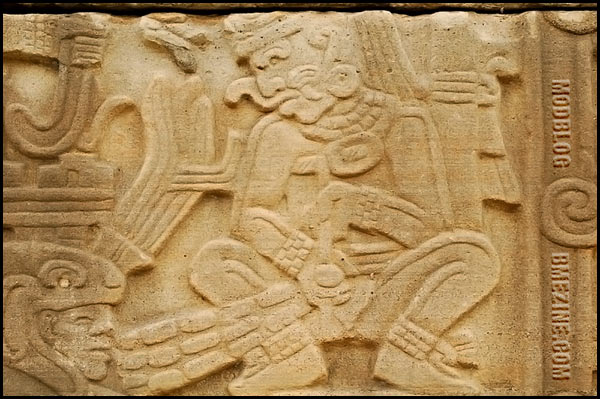
Coming soon!
My friend and occasional BME writer Bizarroboy (see also: Arty Time, Dripping, Eye Can See More, or A Salaryman’s View) just finished a lengthy teaching stint deep in Australia and had a chance to do an interview about ritual cutting (what would be called “self injury” here) and subincision among Aboriginal people in Australia… Watch for that either here or on BME in the next week or two.
